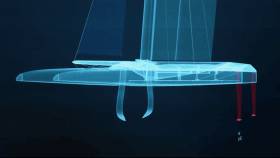Displaying items by tag: Larry Ellison
America’s Cup Winners Launch New Stadium Racing League
America’s Cup winners Larry Ellison and Sir Russell Coutts have launched a new stadium yacht racing league to challenge the Auld Mug’s dominance of inshore team racing.
Described by Oracle co-founder Ellison as “the evolution of sailing”, SailGP will begin its inaugural season in February next year – a little over four months from now – with teams from six countries racing identical 50ft foiling catamarans, designed for high-speed racing in harbour environments that will bring spectators closer to the action on the water.
The F50 catamaran is adapted from the AC50 that raced the most recent America’s Cup in Bermuda, with the specialists at Core Builders Composites in New Zealand spending the last year tweaking the design with the aim of reaching speeds in excess of 50 knots.
Sydney Harbour will hold the debut event from 15-16 February, before SailGP moves on to San Francisco (4-5 May), New York (21-22 June), Cowes on the Isle of Wight (10-11 August), and Marseille in the south of France (20-22 September) for the finale.
The World Sailing-sanctioned SailGP is the brainchild of Ellison and Sir Russell, respectively owner and CEO of Oracle Team USA — winners of the 2013 America’s Cup in dramatic fashion.
They have devised a competition that will see five fleet races each round, their results determining the two best teams who will race a head-to-head final in each host harbour.
In the final round, a winner-takes-all match race between the season’s top two teams will be held with $1 million up for grabs.
However, SailGP co-founder Sir Russell has played down suggestions that the concept is a rival to the America's Cup, saying that the two competitions were "absolutely not" at odds.
Sir Russell was speaking at the launch event for SailGP in London this week, which also unveiled the British team that will be taking part.
“The concept of SailGP immediately excited me,” said Dylan Fletcher, Rio 2016 Olympian and helmsman of the Great Britain SailGP team.
“This league allows us to compete with and against the best, and to challenge ourselves in every way possible while sailing the world’s fastest catamarans.”
Cheeky Chinese Challenge?
This is an interesting challenge to the present US holders, computer software billionaire Larry Ellison's Oracle Racing team which decided to have the event hosted by the San Francisco Yacht Club, which prides itself as being "the oldest club West of the Mississippi in North America."
It will be the first time the America's Cup has been hosted in the United States since 1995 and it is interesting to speculate whether the Chinese are cheekily challenging the Americans who don't like the Cup going outside of the States.
Racing will be held on the iconic San Francisco City front and be visible from world-renowned tourist destinations such as the Golden Gate Bridge.
"My support for San Francisco hosting the America's Cup goes beyond the opportunity to see our team competing on home waters," said Russell Coutts, CEO, ORACLE Racing. "We are excited to sail for our sport's greatest trophy, on a stretch of water legendary among sailors worldwide."
The China Team has been given the backing of the Chinese Government and has already been designing a boat for the 34th Cup event which will be raced in 72-foot wing-powered catamaran multihulls.
"We have been working with some of the best worldwide designers for hulls and wings for a few months in partnership with top Chinese universities," the Team Leader, Wang Chao Yong, said. "This is an opportunity to showcase Chinese talents at the leading edge in hi-tech areas of both hydrodynamics and aeronautics. Our boat will be built in China."
The Chinese made an unsuccessful attempt on the 2007 America's Cup. While the intention is that most of the sailors on their America's Cup team will be Chinese there is to be, as in the 2007 attempt, a French influence. Thierry Barto has been appointed Chief Executive Officer and given the task of getting top sailors to coach the Chinese team.
It seemed initially that interest might be lacking in the 162-year-old event. However ten teams have signed up to take part in the 34th America's Cup.
Aside from the defender, Oracle, entries include Team New Zealand, Italian syndicate Mascalzone Latino - the official challenger of record - and Artemis of Sweden. Two French teams and the Chinese have also paid their entry fees. America's Cup Racing Management says two other unidentified teams, one of which is believed to be Italy's Venezia Challenge, will take part. Whether all of the existing entries make it to the start line of the challenger elimination series in July of 2013 will be interesting. There was major legal action before the event was re-scheduled for 2013. Oracle and Ellison declared their preference for a defence in San Francisco as the "home club".
Two of the three possible French challengers had talks with the Minister for Sport in Paris last Friday to discuss amalgamation and whether there would be French government support. There is also an "Argo Challenge" from a group of disabled sailors.





























































